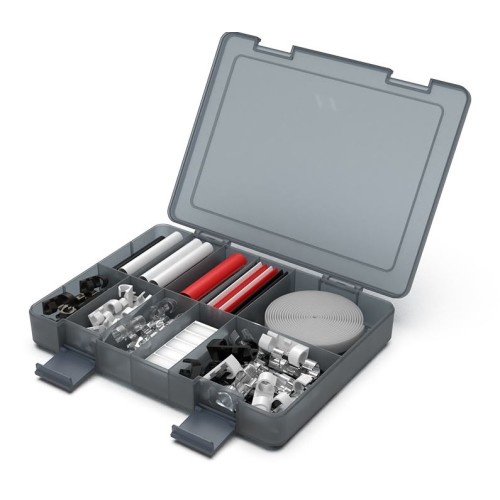
A fully equipped tool chest is a tradesperson's prime asset for core activities like assessing timber and inserting hardware precisely. This guide will equip you with the knowledge to select the right tools and utilize them effectively.
- Initiate your toolkit by collecting essential hand tools like a hammer, screwdrivers, wrenches, pliers, saws, and tapes.
- Become familiar with tool functionality and the unique contexts where they apply.
- Build competency by practicing on projects and incrementally increasing challenge.
Keep in mind investing effort to master hand tools builds your craftsmanship. With proper knowledge, they will become valuable extensions of your abilities, allowing you to accomplish even the most demanding projects with confidence and precision.
Level Up Your Workflows with Power Tools
Prepared to supercharge projects? Explore robust power tools blending precision with speed. These must-have tools can change the game for professionals and casual builders alike. From heavy drills to precision cutting saws, power tools bring numerous capabilities for building projects.
- Leverage cordless impact drivers to streamline fastening and demolition jobs.
- Perfect use of reciprocating saws to achieve speedy and clean cuts across materials.
- Improve woodworking outcomes via strong planers and jointers providing fine finishes.
Tap into power tool benefits to shorten completion times and enhance final outcomes.
Precision Made Easy
When fine detail matters, selecting proper measuring instruments changes outcomes dramatically. From common tapes to advanced digital calipers, measurement aids support accurate execution of designs. Whether expert artisan or starter hobbyist, proficiency with measuring devices yields more possibilities.
- Investigate the wide selection of measuring devices catering to varied needs.
- Familiarize yourself with applications and advantages of each measuring device.
- Advance your capability in precise measurement and practical usage.
Sets for All Needs
Regardless of experience level, the right collection of tools is necessary for project success. In jobs from screwwork to furniture assembly, a proper set ensures efficient, safe and accurate results. Base your toolkit selection on the nature of jobs you do often.
Will a comprehensive multi-tool set be useful or is a specialized kit sufficient? Once needs are set, examine brands and models for comparative quality, functionality and cost. Don't forget to read online reviews from other users to gain valuable insights before making your final decision.
With proper planning and review, you can choose a set that enables you to finish projects confidently.
Hand Tool Maintenance: Keeping Your Gear in Top Shape
Regular care of hand tools remains essential for reliable craft work. Failing to care for tools results in dullness, breakage and poor work quality. Consistent upkeep keeps tools performing well and extends their service life. Post-use cleaning removes dust and debris to protect tools. Keep tools stored dry to avoid rust and corrosion.
- Sharpen cutting tools consistently with a stone or fine file.
- Use recommended oil on moving parts to cut friction and prevent wear.
- Inspect handles for cracks or damage and replace them as needed.

Adhering to these maintenance practices will lengthen the lifespan of tools and enhance your workflow.
Essential Hand Tools for the Home Workshop
A properly outfitted workshop becomes a sanctuary for DIYers and tinkerers. Even with specialty gear, essential hand tools remain central to varied tasks. Necessary items are a good hammer, adjustable wrench and robust tape measure for precise measurements. Remember to have varied screwdrivers, pliers for manipulation and a utility knife for slicing materials. A quality saw provides precise cutting and a level keeps work aligned and even.
- Crucial Hand Tools for a Personal Workshop

Power Tool Safety Demystified: Complete Resource
Power tools are potent machines offering strong performance and time savings. However these devices necessitate comprehensive knowledge of protective protocols. Ignoring safety steps might result in major injuries. This handbook simplifies power tool safety and equips you with practices for safe use.
Start with getting to know your tools: study manuals closely and grasp unique safety features. Consistently wear suitable protective gear—safety glasses, ear protection and gloves. Carry out routine maintenance to keep tools functioning properly.
Bear in mind safety is the top priority in any workshop environment. Following these safety tips helps you operate power tools effectively and securely.
Choosing the Right Tools for Accurate Measurement
When seeking measurement precision, selecting the right instruments is important. A diversity of measuring devices is offered, each purpose-built for specific needs. Insight into each tool's attributes is key to choosing properly. Factors such as accuracy, resolution, and measurement type should be carefully evaluated when selecting the right tool for the job.
- For length measuring tasks, a tape measure or ruler is generally used.
- Use a protractor for indispensable angle measurements.
- Digital calipers are ideal for measuring small dimensions.
Choosing measurement tools prudently yields repeatable, reliable accuracy.
Picking the Optimal Tool Set

Searching for the right tool set may be exciting and somewhat intimidating. With a plethora of options available, it's easy to feel overwhelmed. This thorough resource equips you to select the perfect toolkit for your needs.
First off, determine which project types you'll commonly work on. Are you an expert or a novice? Precisely defining aims narrows options.
- Mixing hand and power tools often yields the best, most efficient outcomes Consider using a mix of power and hand tools to achieve productive, efficient results Employ a blend of power and manual tools to reach productive and precise outcomes
- Prioritize the essential tools
- A sturdy hammer or mallet including a sledgehammer
- Screwdrivers Wrenches Pliers: A versatile set collection assortment is crucial
- Measuring Tape Ruler Tape
- Leveling tools like level, plumb bob or transit
Think about tool materials, spending constraints and company reputation. Recall that durable toolsets offer long-run value.
Master DIY Tools with Ease
Beginning your initial DIY project can appear overwhelming. Yet with proper gear and some savvy, the most difficult tasks become doable. Kick off by understanding and becoming acquainted with your tools. Peruse manuals thoroughly and practice techniques in a safe space. Keep in mind safety is always your primary concern. Adopt safety equipment—goggles, gloves and ear defenders—to defend against hazards.
When selecting tools, focus on durability and dependable build quality. Select reputable manufacturers whose tools endure and perform well over years.
Ask for tips from experienced DIYers or professionals at nearby hardware outlets. Ask them for tips, insights and suggestions to find the most suitable tools for needs.
- Always use sharp tools for safer, cleaner work.
- Store your tools properly to prevent damage or loss.
- Don't be afraid to try attempt venture new things
Choosing Power Tools vs. Hand Tools: When to Use Each
Doing repairs or builds? Selecting power or hand tools may present a tricky choice. Even though strong power tools offer great efficiency, hand tools remain crucial for detailed, smaller jobs. Refer to this guide to decide the appropriate tool option for your task.
- Hand tools provide superior control for detailed assembly, carving and intricate repairs. Hand tools commonly offer better control and are more economical options.
- When projects require fast cutting, drilling or sanding, power tools markedly reduce time and effort. They significantly lower manual labor and shorten project timelines.
Finally, whether to use power or hand tools is determined by the project, your expertise and finances. Combine hand and power tools strategically for successful and efficient project completion.
